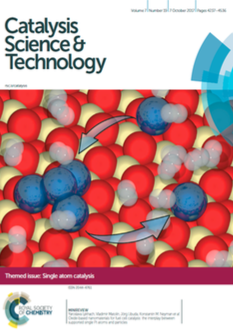Oxide-based nanomaterials for fuel cell catalysis: The interplay between supported Pt atoms and particles
Oxide-based nanomaterials for fuel cell catalysis: The interplay between supported Pt atoms and particles
Y. Lykhach, A. Bruix, S. Fabris, V. Potin, I. Matolínová, V. Matolín, J. Libuda, K. M.Neyman.
Catal. Sci. Technol., 7 (2017) 4315.

Cover image of the Themed Issue on Single atom
catalysis illustrating interplay of single supported on
ceria Pt atoms in the catalyst at rest and small Pt
clusters formed from such single atoms at the working
fuel cell conditions of H2 dissociation and oxidation
The concept of single atom catalysis offers maximum noble metal efficiency of lowcost catalytic materials. We presented our experimental and theoretical modelling efforts to fabricate and characterize single atom anode fuel cell catalysts on nanostructured ceria. The remarkable performance and durability of these catalysts with ultra-low Pt loading is related to the interplay between two states associated with supported atomically dispersed Pt and subnanometer Pt particles. These two states result from strong interactions between Pt and nanostructured ceria that yield atomic Pt species under oxidizing conditions and small Pt particles under reducing conditions. The square-planar O4 site on small {100} terraces is the key structural element on the surface of ceria nanoparticles where atomic Pt is anchored as Pt2+. The conversion of Pt2+ species to Pt particles is triggered by a redox Ce4+/Ce3+ process. The abundance of adsorption sites similar to those on the {100} terraces determines the ideal (maximum) Pt loading in Pt–CeOx films that still allows reversible switching between Pt atoms and small particles yielding high activity and durability of such smart catalysts during fuel cell operation.
